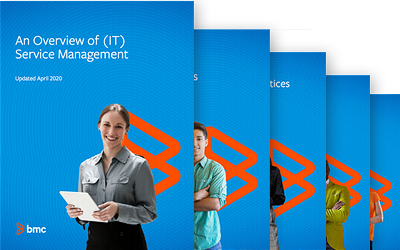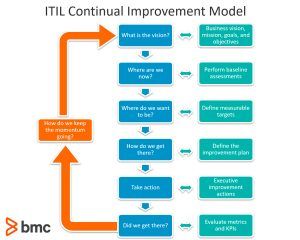The Risk Management Continuous Improvement Model Includes Quizlet
Continual improvement encompasses all elements of the ITIL SVS. It involves aligning an organization's practices and services with changing business needs, through the ongoing assessment and improvement of each element involved in the management of products and services. Continual improvement applies to the SVS in its entirety, as well as to all of the organization's products, services, service components, and relationships, and is the responsibility of every individual involved in service management.
Download Now: ITIL 4 Best Practice e-Books
These all-new for 2020 ITIL e-books highlight important elements of ITIL 4 best practices. Quickly understand key changes and actionable concepts, written by ITIL 4 contributors.

To support continual improvement at all levels (strategic, tactical and operational), the ITIL SVS includes:
- The ITIL continual improvement model, which provides organizations with a structured approach to implementing improvements
- The improve service value chain activity, which embeds continual improvement into the value chain
- The continual improvement practice, supporting organizations in their day-to-day improvement efforts
(This article is part of our ITIL 4 Guide. Use the right-hand menu to navigate.)
The ITIL Continual Improvement Model
The ITIL continual improvement model can be used as a high-level guide to support improvement initiatives. Through its iterative approach, it increases the likelihood that ITSM initiatives will be successful. It puts a strong focus on customer value, and ensures that improvement efforts can be linked back to the organization's vision.

Let's look at the seven steps of the continual improvement model in detail. Note that the scope and details of each step of the model may vary significantly based on the subject and the type of improvement.
Step 1: What is the vision?
The first step is to define the vision of the initiative, which should support the organization's goals and objectives, provide context for all subsequent decisions, and link individual actions to the organization's future vision. This step focuses on two key areas: the organization and the initiative.
For example, Uber's vision is "We ignite opportunity by setting the world in motion", while the vision for an improvement initiative could be "To enhance the Uber app's navigation to better identify alternative routes". If this step is skipped, improvements might only be optimized for the people or teams involved rather than the whole organization, or non-value-adding activities might become the sole focus of improvements.
Step 2: Where are we now?
The second step is to conduct an objective current-state assessment of existing services and service management practices. This should include consideration of the users' perception of the value being received, along with a review of people's competencies and skills, the processes and procedures involved, the capabilities of the available technological solutions and the prevailing organizational culture. The success of an improvement initiative depends on a clear and accurate understanding of the starting point and the required impact of the initiative.
For example, an organization can measure the current net promoter score (NPS) from a customer satisfaction survey, conduct a benchmark survey against its competitors or review findings of operational statistics or audit reports to understand its current state. If this step is skipped, the current state will not be understood and there will not be an objective baseline measurement against which improvement can be measured.
Step 3: Where do we want to be?
The third step defines one or more prioritized actions along the way to completing the vision for the improvement, based on the current state assessment. Here, improvement opportunities can be identified and prioritized, improvement objectives can be set, along with critical success factors (CSFs) and key performance indicators (KPIs). The agreed objectives, CSFs and KPIs need to be SMART i.e. specific, measurable, achievable, relevant, and time-bound.
For example, an organization can identify improvement in market share from the current 10% to 25% within the next two years. If this step is skipped, the target state will remain unclear. It will be difficult to prepare a satisfactory explanation of what key stakeholders stand to gain from the improvement initiative, which may result in low support or even pushback.
Step 4: How do we get there?
The fourth step involves outlining the actual plan to fulfil the actions defined in step 3. This plan may take a straightforward and direct route, or may involve a series of experiments to assess different options for achieving the goal. It is often most effective to progress in an iterative way, as this ensures that the organization can check progress, re-evaluate and refine the approach, and even change direction if appropriate.
For example, to raise customer satisfaction, the organization may create a plan to enhance capabilities of its customer service team through training or investment in a customer relationship management (CRM) system.
If this step is skipped, the execution of the improvement is likely to flounder and fail to achieve what is required of it. Failed improvements erode confidence and can make it difficult to get support for future improvements.
Step 5: Take action
The fifth step is the execution of the plan that was created in step 4. Depending on the size of the initiative as well as the execution approach, it is important to remain focused on achieving the desired outcome. Whether the plan is executed in a waterfall or agile manner, in a big-bang approach or multiple small iterations, what matters most is to ensure the organization's target state is achieved. Therefore measuring progress during this step is critical.
For example, an organization may take action to automate some of its manual data processing activities. It may use a pilot to check effectiveness before rolling out the improvement in multiple business units. If this step is skipped, there is no value in the entire improvement initiative and all the previous steps could have been a waste of time and effort.
Step 6: Did we get there?
The sixth step involves checking whether the target state defined in step 3 was reached after taking action in step 5. Here, both the progress (have the original objectives been achieved?) and the value (are those objectives still relevant?) need to be checked and confirmed. If the desired result has not been achieved, additional actions to complete the work are selected and undertaken, commonly resulting in a new iteration.
For example, management will require a follow up survey to check whether customer satisfaction or market share has improved following the execution of the improvement plan. If this step is skipped, it is hard to be sure whether the desired or promised outcomes were actually achieved, and any lessons from this iteration, which would support a course correction if needed, will be lost.
Step 7: How do we keep the momentum going?
In the seventh step, based on the successes identified in step 6, the organization shifts focus to marketing these successes and reinforcing any new methods introduced. This ensures that the progress made will not be lost, and builds support and momentum for the next improvements using techniques from organizational change management and knowledge management practices. Where the initiative fails to achieve success, a thorough analysis needs to be carried out, with learned lessons shared with stakeholders in a transparent manner. This ensures that some level of value is retained by the organization despite the lack of success.
For example, the organization may entrench new practices through policies and training, while enacting punitive measures to prevent falling back to old ways. If this step is skipped, then it is likely that improvements will remain isolated and independent initiatives, with any progress made being lost over time. It may also be difficult to get support for future improvements, and to embed continual improvement in the organization's culture.
Continual improvement and the guiding principles
All the principles are applicable and relevant at every step of an improvement initiative. However, some of the guiding principles are especially relevant to specific steps of the continual improvement model. Following these principles at every step of an improvement increases the chances for success of both that step, and the overall improvement initiative.
| Focus on value | Start where you are | Progress iteratively with feedback | Collaborate and promote visibility | Think and work holistically | Keep it simple and practical | Optimize and automate | |
| What is the vision? | √ | √ | √ | ||||
| Where are we now? | √ | √ | |||||
| Where do we want to be? | √ | √ | √ | √ | |||
| How do we get there? | √ | √ | √ | √ | |||
| Take action | √ | √ | √ | ||||
| Did we get there? | √ | √ | √ | ||||
| How do we keep the momentum going? | √ | √ | √ | √ |
Contribution of Continual Improvement in the Service Value Chain
- Plan: The continual improvement practice is applied to planning activities, methods, and techniques to make sure they are relevant to the organization's current objectives and context.
- Engage, design and transition, obtain/build, and deliver and support: Each of these value chain activities are subject to continual improvement, and the continual improvement practice is applied to all of them.
- Improve: The continual improvement practice is key to this value chain activity. It structures resources and activities enabling improvement at all levels of the organization and the SVS.
ITIL 4 Best Practice e-books
These all-new ITIL e-books highlight important elements of ITIL 4 best practices so that you can quickly understand key changes and actionable concepts. Download now for free!

These postings are my own and do not necessarily represent BMC's position, strategies, or opinion.
See an error or have a suggestion? Please let us know by emailing blogs@bmc.com.
BMC Brings the A-Game
BMC works with 86% of the Forbes Global 50 and customers and partners around the world to create their future. With our history of innovation, industry-leading automation, operations, and service management solutions, combined with unmatched flexibility, we help organizations free up time and space to become an Autonomous Digital Enterprise that conquers the opportunities ahead.
Learn more about BMC ›
Source: https://www.bmc.com/blogs/itil-continual-improvement/

0 Response to "The Risk Management Continuous Improvement Model Includes Quizlet"
Post a Comment